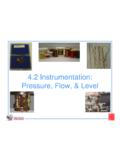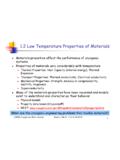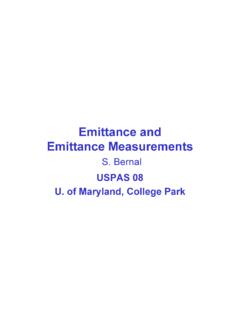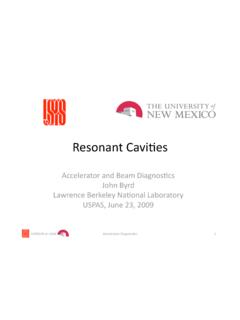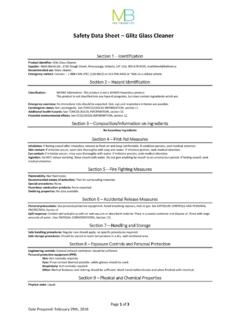Transcription of Page 1 Vacuum Calculations USPAS June 2002
1 USPAS June 2002 Vacuum CalculationsPage 1 Lou BertoliniLawrence Livermore National LaboratoryJune 10-14, 2002 The US Particle Accelerator SchoolVacuum System Design CalculationsThe US Particle Accelerator SchoolVacuum System Design CalculationsUSPAS June 2002 Vacuum CalculationsPage 2 Calculating Steady-State Pressure Profiles using VACCALC)/mliters/sec-(nTorr gasload = q c)/m(liters/se speed pumping = s ec)m(liters/s econductanc = c (m) length beamline axial = z where0 = q + sP - dzdPcdzd qsl cRef. A Method for Calculating Pressure Profiles in Vacuum Pipes , Sullivan, SLAC, 1993 USPAS June 2002 Vacuum CalculationsPage 3 VACCALC Input Each beampipe element is described by the following characteristics: Lumped or distributed values.
2 Length (m) Axial conductance (liters/sec) Outgassing rate (nTorr-liters/sec) Pumping speed (liters/sec) Segment length ( z) is specified for all elements (10,000 segments max. per pipe). USPAS June 2002 Vacuum CalculationsPage 4 Sample VACCALC Input FileModel of LCLS Undulator Beam SegmentsFirst 1 2 LIN 20 2 3 LIN SpeedConductanceOutgassing loadLengthSegment LengthUSPAS June 2002 Vacuum CalculationsPage 5 System Design: MotivationThis effort is undertaken to provide an understanding of thecritical issues ( conductance limiting components, surfaceoutgassing and leak rates) in order to design the most cost-effective pumping pumping Calculations can lead to over-designing thepumping system which can escalate the costs for a largeaccelerator goal is to develop a numerical model of the Vacuum sys-tem whether simple or June 2002 Vacuum CalculationsPage 6 System Design.
3 Motivation The goal is to develop a numerical model of the Vacuum system whether simple or complex. This efforty is undertaken to provide an understanding of the critical issues ( conductance limiting components, surface outgassing rates and leak rates) in order to design the most cost-effective pumping system. Simple pumping Calculations can lead to over-designing the pumping system which can escalate the costs for a large accelerator June 2002 Vacuum CalculationsPage 7 Designing a system using a numerical model In the mid-1990 s, we at LLNL started using numerical modeling to design the Vacuum systems for the APT RFQ and linac. Later we used it to design the Vacuum systems for the SpallationNeutron Source June 2002 Vacuum CalculationsPage 8 Typical features of a numerical model Pressure histories are solved for each sub-volume.
4 We save the pumpdown history for specific sub-volumes of interest. We can employ separate time-dependent outgassing rates for pre-and post-conditioned surfaces. We can employ pressure-dependent pump speeds. We can do parametric studies of pump speeds and pump distribution, We can even run partial-pressure June 2002 Vacuum CalculationsPage 9 Simple example: distributed pumpingalong a beam tube1234567891011121315 CaCbCcCdC060 metersCTICT-81500 lps cryo pumpVarian VacIon Plus 300noble diode ion pumpCTtube,eachpumpCeCfCgChCiCjCkClCmCn1 416Cp17C018Cp19C020Cp20 sub-volumes interconnected with 16 conductancesCa-Cpand pumped with 15 ion pumps and 1 cryo pumpUSPAS June 2002 Vacuum CalculationsPage 10 Complex example.
5 Pumping using a manifold along an rf linacModel the first twelve cavities with a length of meters (per manifold)and extrapolate results to the full length (10's to 100's of meters)rf window assemblywith separatepumping systemUSPAS June 2002 Vacuum CalculationsPage 11 Detail of the first six cavities of an rf linacris er to rfw in do w(once every 12 cavities)Goal: Pump through the coupling cavities and accel cavities to maintain the operating pressure of 10-6 Torr within the beam tubecoupling cavityaccel cavityportto manifold(bottom of eachcoupling cavity) USPAS June 2002 Vacuum CalculationsPage 12 Internal cavity detail included in the modelSlot between coupling cavity and accel cavityDrift tubeEnd noseProton beamAccel gapAccel cavityUSPAS June 2002 Vacuum CalculationsPage 13 For twelve cavities, conductances interconnect 83 sub-volumes (half-symmetry)
6 Coupling cavityco up lin g cavityaccel cavitiesgate valvebridge couplerIon Pump A 55 l/sRough 300 l/mTurbo 70 l/sCdt drift tube= 21 Cdt Cag Cbe Csl Cbe Csl Csl Csl, slot = 242 Cnp Csl Csl Csl Cag Cag Cag Cag accel gap = 51 Cag Cdt Cdt Cdt Cdt Cbe Cbe Cbe & end nose = 11 Cbe Csl Cnp nipple = 70 Cnp CtblCtblCtbl, tube &bellows = 55 Cip, ion pump port = 130 Cmfion,manifold to ion pump = 293Cm-between manifold thirdsmanifold left sidemanifold centerCmfturbo, manifold to turbo = 293 Cip, turbo pump port = 9381827543216362505876964666851525354551 211101316151417201918212423222576647765 Volume = 46 L Area = 67000 cm2 USPAS June 2002 Vacuum CalculationsPage 14N ordinary differential equations must be solved simultaneously for each time where N = the number of sub-volumesGasload balance is the hearty of the numerical Vn= volume of the nth sub-volume (liters)Pn= pressure of the nth sub-volume (Torr)there are N pressures to solve for at each time t (sec)Qin= leakage or outgassing into volume n (Torr-liters/sec) Qout= Cnm(Pn-Pm)
7 Where m is the adjacent sub-volume Cnm= your favorite conducatance formula for the resistive component between sub-volumes n and m (liters/sec) or Qout= SpPnwhere Spis pressure-dependent pump speed ====outinnnQ - Q dtdPVUSPAS June 2002 Vacuum CalculationsPage 15 Pressure history for each pump phase is found for each of the N sub-volumes. Modol solve sfor pressure with N coupled differential equations (for each N sub-volumes) during each time for each pumping phase: Roughing phasefrom atmospheric pressure down to 50 mTorr Turbopumping phasefrom 50 mTorr to 10-6 Torr Ion pumping phasedown to base pressure Note that the choice of pump type depends on the design and operational requirements.
8 Note that the final time for the pumpdown history should be chosen based on characteristics of outgassing data and operational June 2002 Vacuum CalculationsPage 16 The software tool to solve the model depends on the number of sub-volumes and the speed of your computer. You can build your own solver routine using your favorite language and computer. You can use a routine like rkfixedfrom MathCad. You can use a routine like NDSolvefrom Mathmatica. We have solved small problems (N<10 sub-volumes) using MathCad on a PC in less than one hour. For larger problems, it is worth learning Mathmatica. Example: N = 83 sub-volumes with tress separate pumping phases, the computer processing time was min on a 266 MHz G3 PowerMac.
9 With MathCad, the problem would have taken days due to the overhead needed to MathCad more user friendly with a cleaner June 2002 Vacuum CalculationsPage 17 Model can include multiple time-dependent outgassing rates for pre-and post-conditioned based on early data from Roth, fromHot Model tests,* and final specified outgassing goals10-1110-1010-910-810-7 Outgassing rateTorr-L/sec/cm2 Time (hrs)Post-rfConditioning x 10-8exp( x10-3t) + x 10-8exp( x10-4t) + x 10-9exp( x 10-5t) +1 x 10-10exp( x 10-5t) +1 x 10-10where t = secPre-rfConditioning x 10-8exp( x10-3t) + x 10-8exp( x10-4t) +2 x 10-9exp(-6 x 10-5t) +6 x 10-10exp(-7x10-6t) + x 10-9where t = secRoth dataHot x x 10-10 Note: lower ratesare achievableafter 100 June 2002 Vacuum CalculationsPage 18 Pressure dependence of speed for a Varian dry scroll (L/sec)P re s s u re ( To rr)Fitto dots:S(L/s)= (log(P )+ )S p e e d c u rv e fo r V a ri a n 610(L/min)dryscrollpumpDots are from scanof catalog dataCan turn offrough pump herethen turn on turboUSPAS June 2002 Vacuum CalculationsPage 19 Pressure dependence of a speed for a Varian turbomolecular pump0408012010-610-50.
10 (L/sec)P re s s u re ( To rr)Fitto dots:S (L/s) = exp ( )+ exp ( P ) + 5. 6545S p e e d C u rv e fo r V a ri a n T u rb o -V150 HT P um pDots are from scanof catalog dataCan turn onturbo hereCan turn off turboaround 10-6or lessto then turn onion pumps for long termuninterrupted use andminimal maintenanceUSPAS June 2002 Vacuum CalculationsPage 20 Pressure dependence of a speed for a Varian Starcell ion pump40608010012014010-1010-910-810-710-6 10-5 PumpspeedL/secPressure (Torr)S (l/s) = + (Sin(Log(P) )) (Sin(Log(P) ))4+ (Sin(Log(P) )) (Sin(Log(P) ))6 Fit is good for 5x10-9to 5x10-5 TorrDots are from scanned graph in catalogLine is the fit to the dotsAn input of constant nominal speed of 150 L/secwould have predicted an erroneously low pressure10-4 USPAS June 2002 Vacuum CalculationsPage 21 All ion pumps are not alike20022024026028030010-1010-910-810-7 10-610-5S = - log(P) + log3(P)+ log4(P)+ log5(P)+ log6(P)Scanned fromcatalogPumpspeed L/secPressure ( Torr)Pump characteristics with nitrogen for 300 L/s conventional PHI ion pumpUSPAS June 2002 Vacuum CalculationsPage 22 System response to a perturbation can be studied such as a failed tube pressure (10-7 Torr)Time (seconds)
